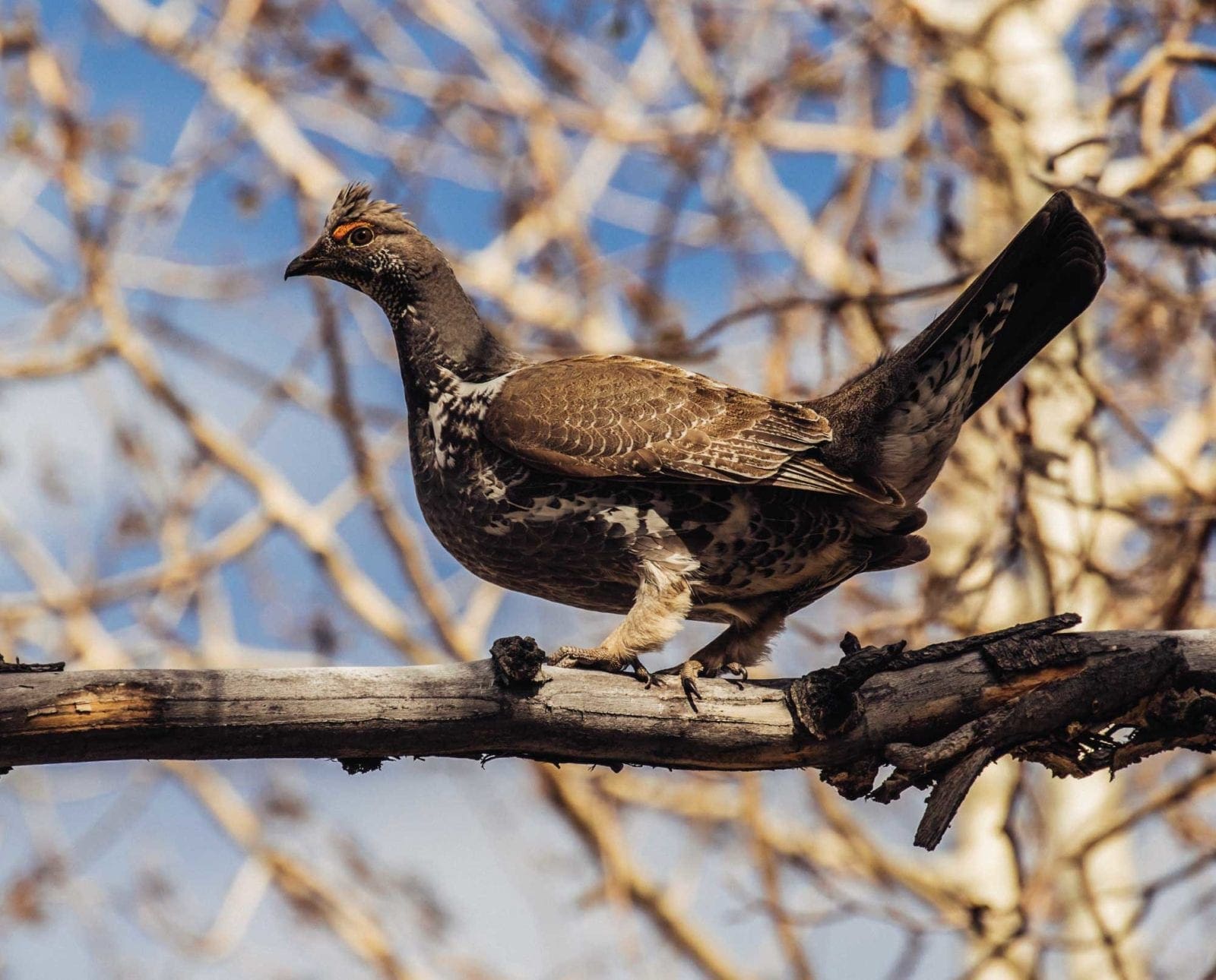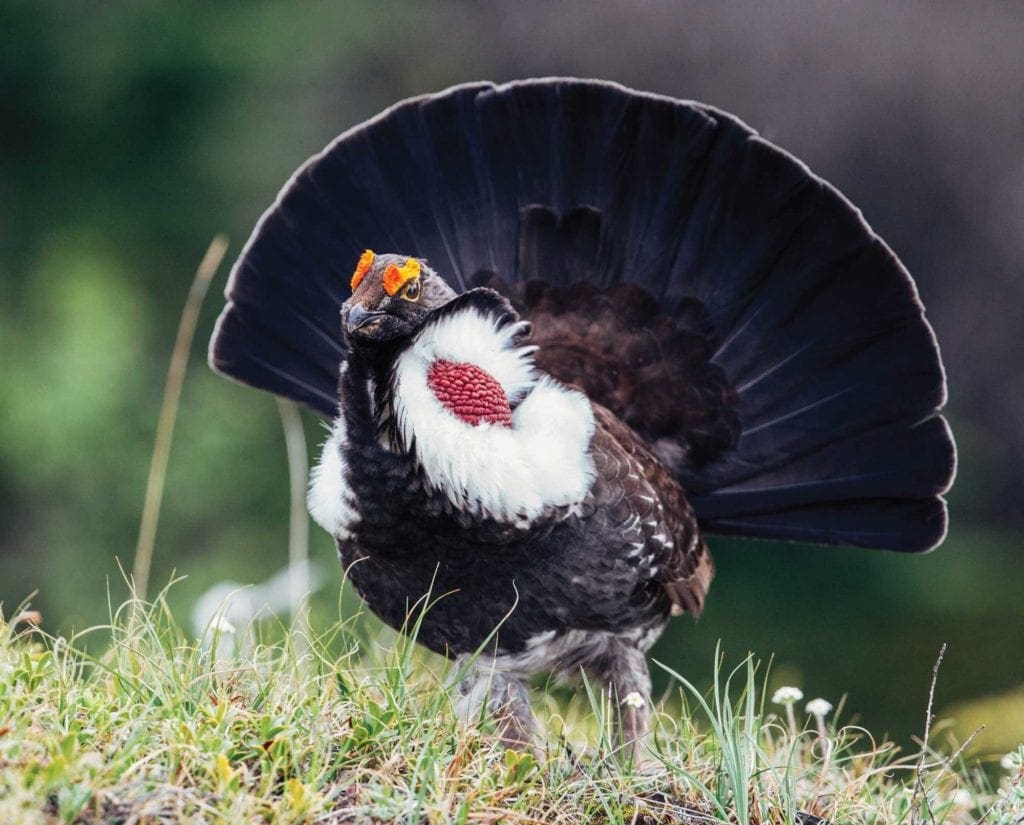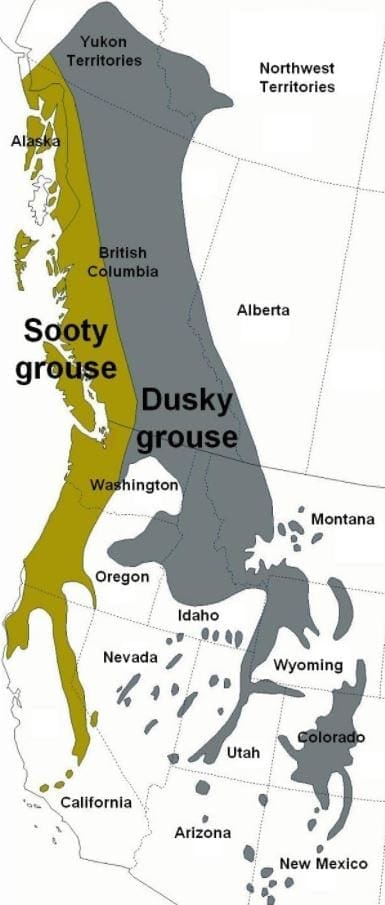Home » Grouse Species » Blue Grouse Hunting » Splitting the Blue Grouse into the Sooty and Dusky Grouse
Splitting the Blue Grouse into the Sooty and Dusky Grouse

Ryan Lisson is a biologist and regular content contributor to…
Learn why the blue grouse was split into two subspecies as well as identifying birds and range
The blue grouse is a bird shrouded in mystery. The dusky grouse (Dendragapus obscurus) and the sooty grouse (Dendragapus fuliginosus) were first identified separately by Lewis and Clark in the 1800s. They were later combined into one species called the “blue grouse” in the 1900s. It remained that way until 2006, when the American Ornithologist’s Union decided to once again split the species into two separate species (Washington Department of Fish and Wildlife 2018).
Why all the back and forth? At a quick glance, it’s easy to see why the blue grouse remained a single species for so long. The males can look essentially the same with only minor physical differences, while the females look nearly identical. They occupy many of the same types of habitat, especially along the transition area between the currently accepted ranges. And they are also suspected to interbreed where their ranges overlap, further complicating identification.
However, DNA research offered sufficient evidence in 2006 to split the blue grouse into the sooty and the dusky grouse again. That obviously wouldn’t do you much good in the field. But fortunately, there are a few key physical differences and situations you can use to identify them.
Identification comparison for the blue grouse species
The table below lists the identifying characteristics for each species in order of usefulness in the field. For example, the top row is one of the most important identifiers from afar (if a male is displaying), while the bottom row would be impractical to check until you were holding the bird in your hand. Some of these characteristics are physical features, while others are situational (i.e., displaying location and volume of hooting). If you want to be relatively sure of your identification, try to match up as many of these as you can.
Identification of dusky grouse versus sooty grouse
| Trait/Identifier | Dusky Grouse | Sooty Grouse |
| Color of neck/throat air sacs (called apteria) | Red | Yellow |
| Male tail fan color | Solid black, though occasionally with light gray band | Grayish-black with light gray band |
| Overall body appearance | Brown and light gray feathers | Darker gray, brown, and black feathers |
| Typical display location | On the ground | Tree canopies |
| Volume of display hooting | Heard within 100 meters | Heard within 2 kilometers |
| Typical number of tail feathers | 20 | 18 |
Sources: NatureServe 2018; Schroeder 2016; Washington Department of Fish and Wildlife 2018
The images below show the two species side by side so you can see the physical differences described in the table.
As you can see, these two birds look very similar as is. But depending on which part of their range you are in, their feathers may be slightly different colored and the identification features above might be less helpful. For example, in parts of southeast Alaska (where their ranges overlap), sooty grouse have been observed with red throat sacs instead of yellow ones, and in Colorado and New Mexico, some dusky grouse have banded gray tails instead of black ones (Schroeder 2016). Some research shows that the variation of genetics and how birds actually look (phenotype) with these species is pretty large. That means that even within each species, there is a lot of variation in appearance.


Range of the blue grouse species
The dusky grouse mostly occurs on the drier, interior (eastern) sides of our western mountain ranges. It is found throughout the western United States and Canada, primarily occupying Colorado, Wyoming, Idaho, Montana, Utah, Oregon, and Washington, as well as most of British Columbia, Alberta, and the Yukon Territory of Canada.
The sooty grouse usually occurs on the moist, coastal (western) side of our western mountain ranges and coastline. Its range follows the Pacific Ocean coastline from California to Alaska, though some populations also extend through the Sierra Nevada Mountains. They primarily occupy California, Nevada, Oregon, Washington, and Alaska, as well as most of coastal British Columbia, Canada.
The map below shows the approximate range of each species. However, where their ranges intersect, it is not uncommon to find both birds. These are the places where identification can get tricky.

Source: Washington Department of Fish and Wildlife 2018
Summary
To make a long and complicated story short, you should plan to use every one of your observations about these birds to identify them – especially in coastal states and Canada where they overlap. Fortunately, most hunting regulations allow you to take either of the “blue grouse” species in a combined possession limit so you do not have to agonize over identification while hunting.
That being said, it is always good practice to know and study the game animals that give an upland hunter’s life such purpose and excitement. The blue grouse is definitely a worthy opponent in that regard.
Sources:
NatureServe. 2018. NatureServe Explorer: An online encyclopedia of life. Accessed at: http://explorer.natureserve.org
Schroeder, Michael A. 2016. Blue Grouse divided by two equals Dusky and Sooty Grouse. Washington Birder, 14(3).
Ryan Lisson is a biologist and regular content contributor to several outdoor manufacturers, hunting shows, publications, and blogs. He is an avid small game, turkey, and whitetail hunter from northern Minnesota and loves managing habitat almost as much as hunting. Ryan is also passionate about helping other adults experience the outdoors for their first time, which spurred him to launch Zero to Hunt, a website devoted to mentoring new hunters.




Thanks for explaining this! I have wondered why we saw the switch from Blue to Dusky in NM and CO. Interesting to me though is that our Dusky’s tail fan and overall body appearance is consistent with the description of the Sooty. This is one of my favorite birds to eat, favorite of any meat for that matter. I’d like to learn more about what influences their numbers as they have unanticipated highs and lows. And during a good year, there is a time, about late-September until the ground is snow covered when I have a terrible time finding them. They must be moving to eat something new and I haven’t figured out what that is. Tell us more about this grouse.
I think this is sick. once again elitist over educated snobs telling the rest of us what to think say and do!!!!!!!!!!!!!!!!!!!!!!!!!!!!!!!! blue grouse forever.
This division of the blue grouse species seems to be a waste of time and money.
Next will be the division of ruffled grouse because they come in two color phases (brown and grey).
I wonder if caucasian people with blonde hair and brown eyes are a different species of caucasian from people with brown hair and blue eyes even if from the same parents with different sounding voices and habits.
This smacks of a person looking to put their name on the books.
Sad waste of effort for what is the same bird, sure some have different characteristics but so does every species.
Next will be the division of the mule Deer species where males that grow only 3 main tines or less not including brow tines will be different from those the grow a typical four point set.